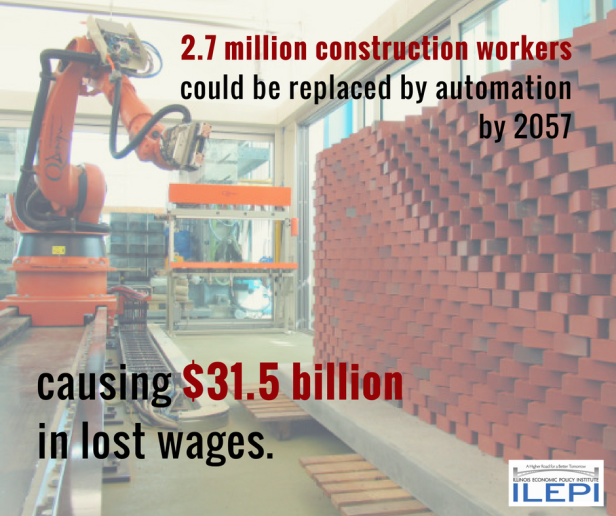What if construction is the next manufacturing, with automation replacing hundreds of thousands of middle-class workers over the next generation? In the future, technological changes that displace human labor in the construction industry could have consequences for workers, families, and the U.S. economy.
A new report by the Midwest Economic Policy Institute (MEPI) and the Project for Middle Class Renewal (PMCR) at the University of Illinois, The Potential Economic Consequences of a Highly Automated Construction Industry: What If Construction Becomes the Next Manufacturing?, finds that technological changes that displace human labor in the construction industry could have devastating impacts on workers, families, and the U.S. economy as a whole.
As the United States continues to grow, infrastructure investments and improvements will be needed to meet new demands. The United States currently has a D+ infrastructure grade on infrastructure and needs $2.0 trillion over the next decade to restore the country’s global competitiveness. Future infrastructure needs will result in more construction projects and more demand for workers. As of 2017, the construction industry employs 6 million workers, including more than 4 million blue-collar workers in construction occupations.
Unfortunately, there is a shortage of construction workers across the nation. Construction firms report difficulties in filling job vacancies, with nearly 200,000 construction jobs across the country left unfilled due to a lack of skilled applicants. The decline of labor unions across the United States coupled with state policy changes to weaken or repeal prevailing wage laws have reduced apprenticeship training and resulted in lower-skilled, lower-paid construction workers. One way that contractors are addressing worker shortages and increasing productivity is by utilizing more machinery, capital equipment, and robots.
There has been a growing concern among many workers, experts, and elected officials on the effects of construction positions becoming less reliant on human labor over time. The introduction of technologies replacing men and women in the construction industry could be devastating to workers and the U.S. economy as a whole. Displaced workers will face unemployment spells and will need to find new sources of income. Preparing for this potential economic change is imperative.
The future of construction has already begun, with technological changes playing a part in the recent rise of capital in the industry. For example, a robotic bricklayer in New York can lay 3,000 bricks a day, while manual labor can lay only 500 bricks a day on average. A Dutch company has created a “Road Printer” that lays brick paving like carpet. The machine can lay 400 yards of road per day with the assistance of only one to three operators.
Virtual reality (VR) technology, augmented reality (AR) technology, and drones can allow a construction team to detect errors ahead of time to avoid costly mistakes. VR, AR, and drones have the potential to improve workplace safety. Not only are projects done faster with automation, projects are also completed with more accuracy and precision while reducing costs and injuries. These technological advancements have made construction more capital-intensive and less labor-intensive.
McKinsey & Company, a management consulting firm, has estimated the percent of tasks in each occupation that can be replaced by robots. The authors note that construction jobs that include running machinery, such as operating engineers, have a higher risk of being replaced by automated technologies. For example, artificial intelligence-controlled machines may be able to displace crane operators and bulldozer drivers within the next few decades. Workers may still be employed in each job classification, but total employment in each occupation could shrink as humans focus only on the tasks that cannot be automated.
Of nine construction trades looked at in the report, roofers have the fewest share of job tasks that can be done by robots at 31 percent, while painters have the highest share at 90 percent. For the five largest construction trades by number of people employed, the automation potential is estimated to be 35 percent for laborers, 50 percent for carpenters, 42 percent for electricians, 50 percent for plumbers and related workers, and 88 percent for operating engineers.

After considering both projected industry growth and technological advancements, it is estimated that the number of construction trades workers could shrink to 2.7 million workers by 2057 as construction becomes a more capital-intensive industry. This would displace nearly 1.5 million workers from existing blue-collar construction occupations. The total jobs gap would be even higher, with workers laid off from existing jobs (i.e., displaced) and hundreds of thousands of jobs forgone for tasks that become automated (i.e., replaced). The decline in good, middle-class construction job opportunities would result in a projected $127.5 billion drop in labor income in the U.S. economy.

A drop in human labor means a drop in labor income, which in turn would result in a drop in overall consumer spending in the economy. As construction becomes increasingly automated over the next generation, the effects of reduced consumer demand could be dramatic. In addition to the 2.7 million jobs gap in construction (which includes 1.5 million displaced workers), another 498,000 jobs in the U.S. economy could be lost as construction workers and their incomes are replaced by automation. The drop in consumer demand among middle-class construction workers would cause another $45.4 billion loss in gross domestic product across the United States (in current dollars).

Thus, an increasingly automated construction industry over the next 40 years could have consequences that mirror the impact of automation in manufacturing. Public policy will play an important role as technological advancements have a larger impact on the construction industry. Proactive steps can be taken to ensure that the benefits of a highly-automated construction industry are shared broadly across the economy.
